I’m Greg Loring-Albright, and usually, I’m making real-world (sometimes called ‘pervasive’) games like scavenger hunts, party games, and treasure hunts. I’ve done this work in both Chicago, where I learned at Waxwing Puzzle Company, and in Philadelphia, where I live now. But the world of board games, ever a hobby, never a serious business opportunity, was too intriguing to ignore for very long.
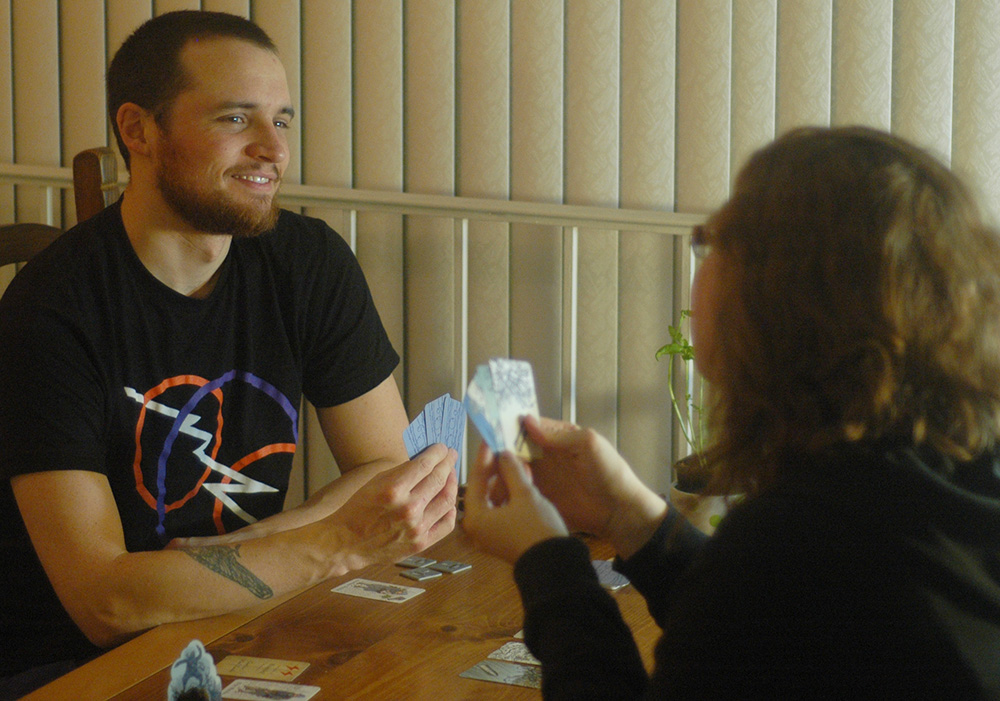
So I made a board game.
First I played a ton of board games, starting with the usual entry points to the hobby (a childhood filled with Monopoly, Sorry, and card games, introduced to Settlers of Catan and Ticket to Ride, and quickly ramped from there, till I was sitting down to play Merchants & Marauders).
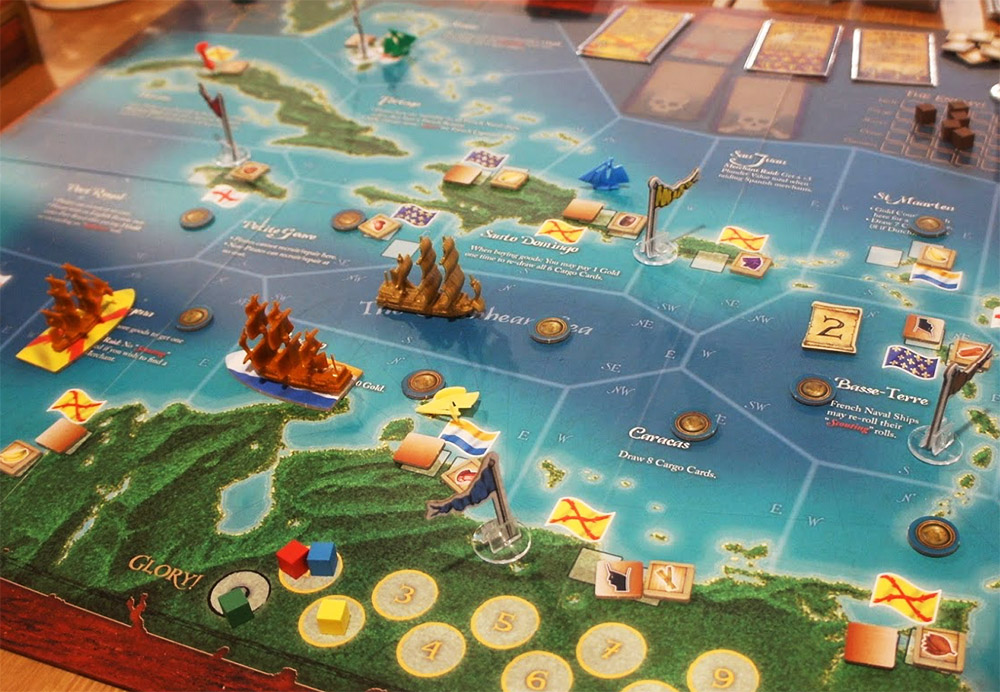
Merchants & Marauders is a big-box pirate game that promises the freedom of the high seas. Want to live as an honest trader? Great! This game provides a complex market economy, letting you ship goods between islands and make a profit. Want to do a little raiding on the side? Great! Buy a fast ship with a few guns and mix legitimate cargo running with the occasional attack on those suckers the merchants. Want to go full pirate? Of course you do! But watch out—the game sends fearsome naval ships across the board, and once they lock onto you, they’re hard to shake! You can, in short, do everything that Errol Flynn or Johnny Depp can do in a pirate movie. The downside? TONS of rules.
I’ve only played this game once, but I loved it, and knew what my game design challenge would be: Make a game that promised the same freedom as M&M (in the same theme, because, for real, PIRATES!), but with fewer rules.
I started without a board—I wanted the game to have a sense of exploration, so I copped a mechanic from another one of my favorite games, Betrayal at House on the Hill: When you leave the tiles that are out, you place a new tile from the top of the stack. This way, the ‘board’ unfolds as players move farther out from the center, ensuring a new distribution of tiles every game.
This core mechanic led quickly to the game’s biggest problem: Once you’d sailed your pirate ship out to the far seas and found something interesting, all the other players had done the same, probably in a different direction, meaning no epic sea battles! I created a mechanic to motivate everyone to return to the center, but that just meant that players took twenty minutes to go out and twenty minutes to come back.
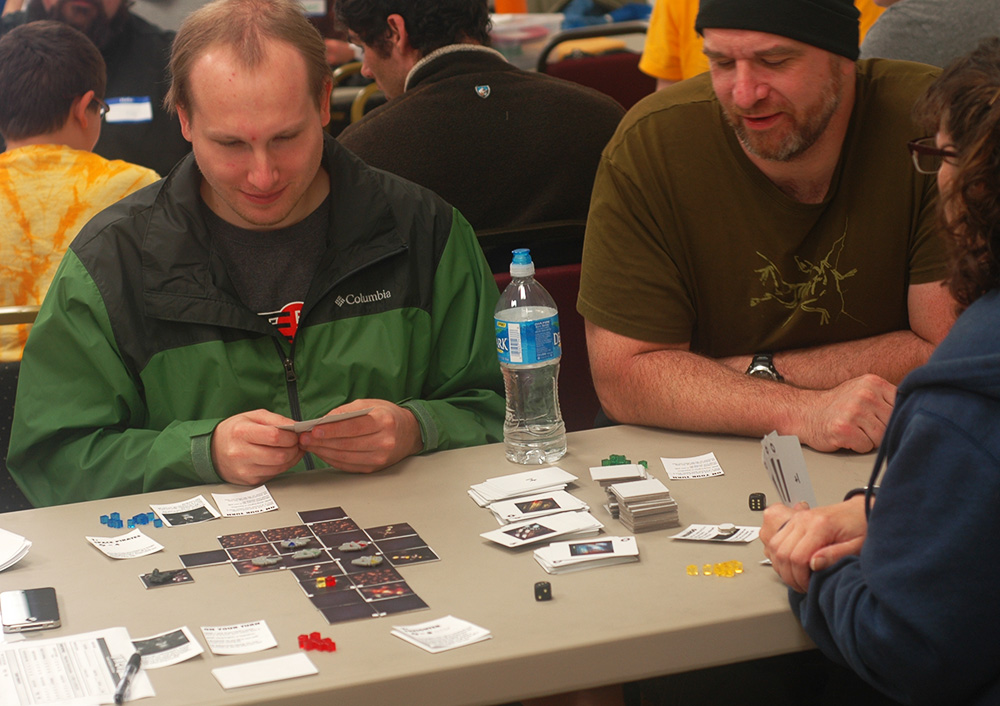
One of my astute playtester friends said: “You need hyperspace gates.”
Immediately, the game had changed. Loath as I was to part with the pirate theme, I realized that my friend had provided an elegant solution that deepened the game immensely.
By assigning each tile a symbol (I used the faces of a 6-sided die to start), and stipulating that players’ ships could move between tiles with matching symbols, I had created a whole new topology: A tile with a 3 on it on the farthest edge of the board was now adjacent to another tile with a 3, a mere 2 spaces from the center! This alternative topology not only solved the transit time problem, but the randomized nature of the board: Now, in addition to generating a new ‘map’ of outer space every game, players were also generating new networks of hyperspace connectivity!
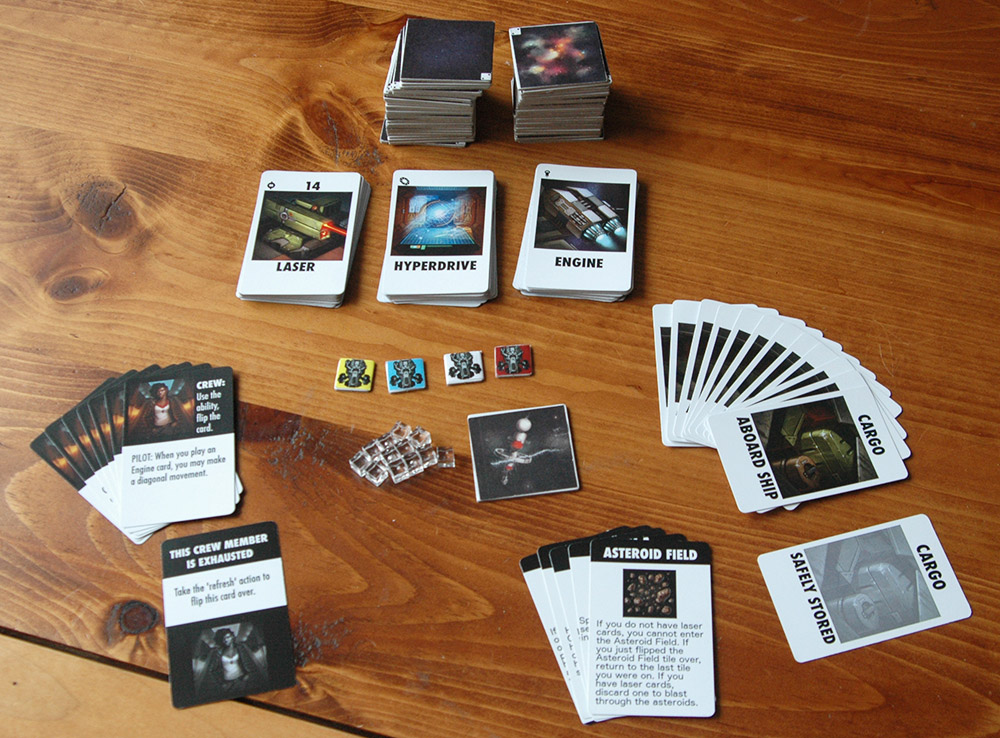
This single change has become the core of the game, and all because of a willingness to ditch the theme that I loved.
Once I had this core mechanic locked down, and had played it with a few trusted friends, I decided that this was a game that was unique enough and fun enough to be published. That was a daunting decision in and of itself, but even more daunting was when I wrote the first check to the game’s artist, John Ariosa. Aside from buying prototype components and the occasional beer for a playtesting friend, that was the first money I put into the game.
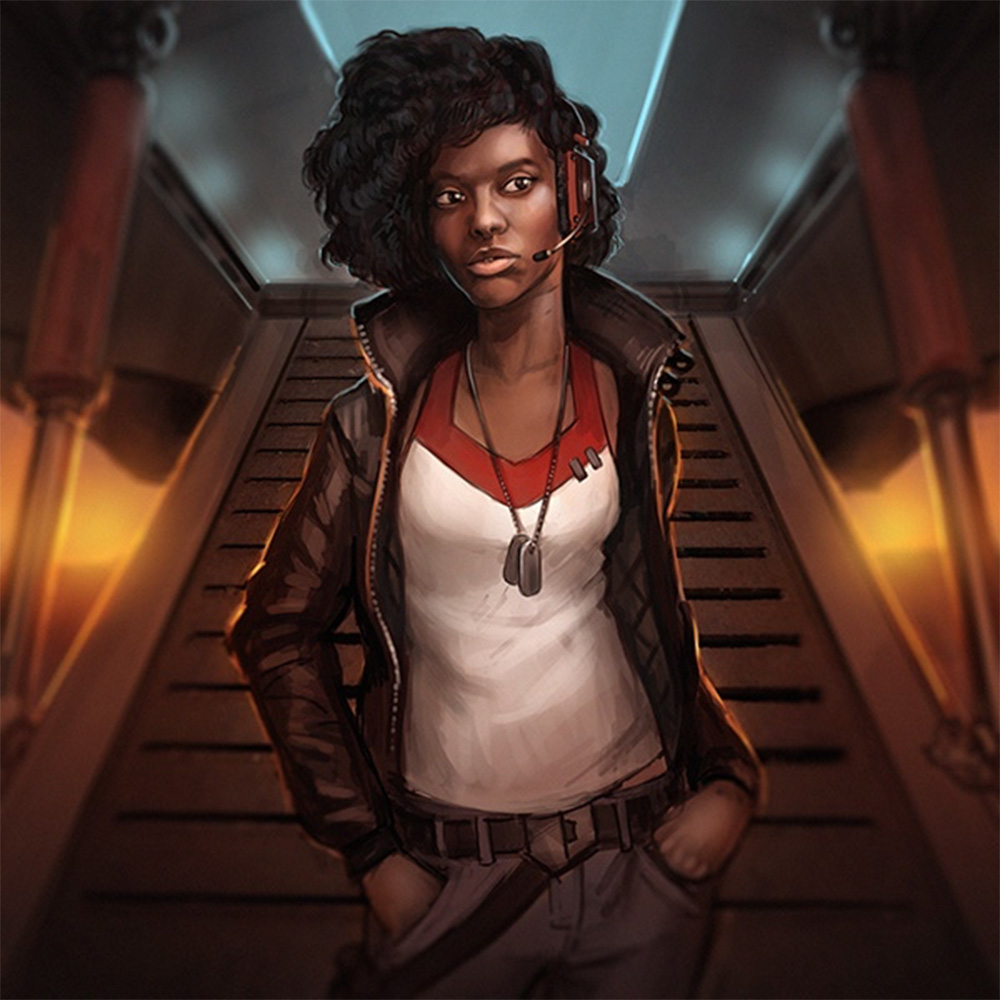
It was incredibly worth it. John is a professional artist, having worked closely with Plaid Hat Games on Summoner Wars and Mice and Mystics, among others. John also works for hire for other Kickstarter projects, which is incredible. The work he did on this game was invaluable in creating the feel for the universe. As soon as I had his art on my demonstration copy, people would inevitably crowd around the table, soaking in the beautiful space-scapes on the tiles. Art, especially John Ariosa’s art, may seem like mere window dressing, but it helps players immerse themselves in the game, and for a game like Hyperspace Smuggler, that immersion is priceless.
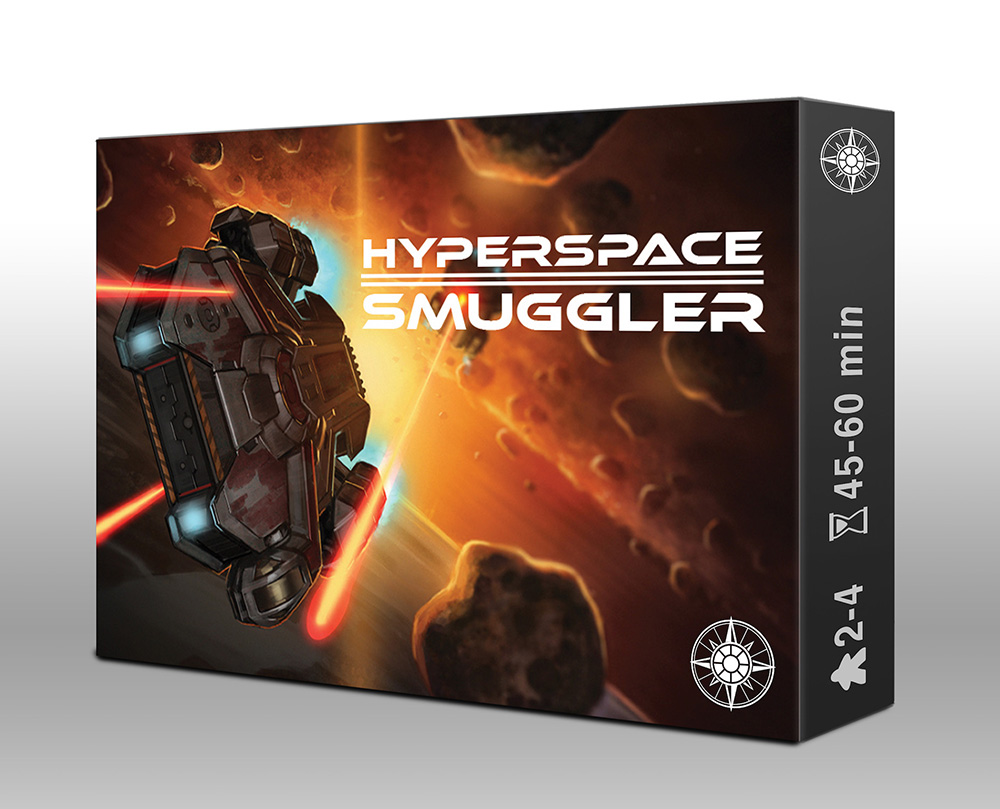
The game has gone through about a full year’s worth of revisions since that fateful playtest. It’s a simple, easy-to-learn game, whose core mechanic (pick stuff up, drop it off, faster than anyone else) is complicated by a system that encourages players to attack each others’ ships, a board that facilitates that attacking (what, you’re close to home and I’m across the galaxy? NOPE, I’ll drop out of hyperspace right on top of you!), and an exploration system that generates new risks whenever you leave known space.
Does it have the sense of total freedom that Merchants & Marauders has? No. Does it have a rulebook the length of a novella? Absolutely not. Does it generate exciting, immersive, dramatic play? I think so, and so do my playtesters.
In short, the game has changed. A lot. It started as a pirate game whose goal was a sense of total freedom, and it became a space game whose goal was a high ratio of excitement-to-rules. And that’s OK. The game where you’re a pirate and can really feel the wind in your hair is still out there. I’ll make it someday.
Hyperspace Smuggler is now live on Kickstarter.
Did you like this story? Please share or comment. Go to this page to submit a story yourself. Subscribe to our online magazine here!
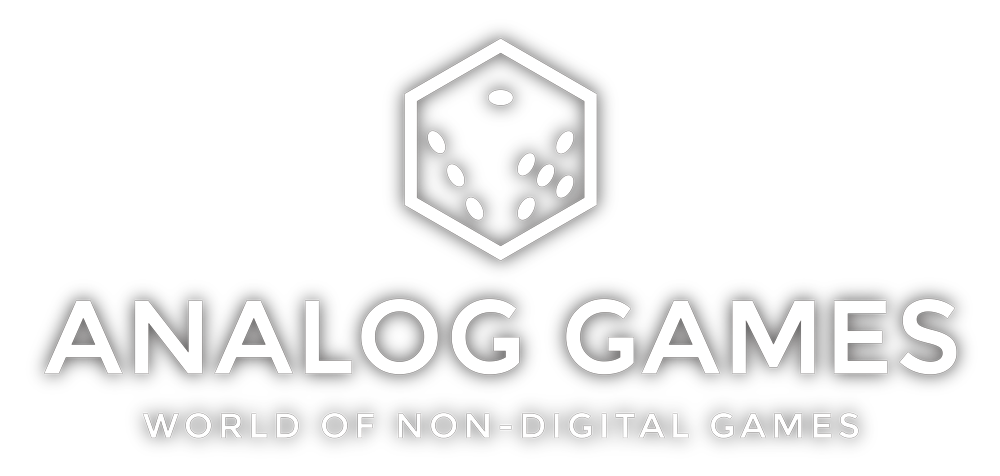
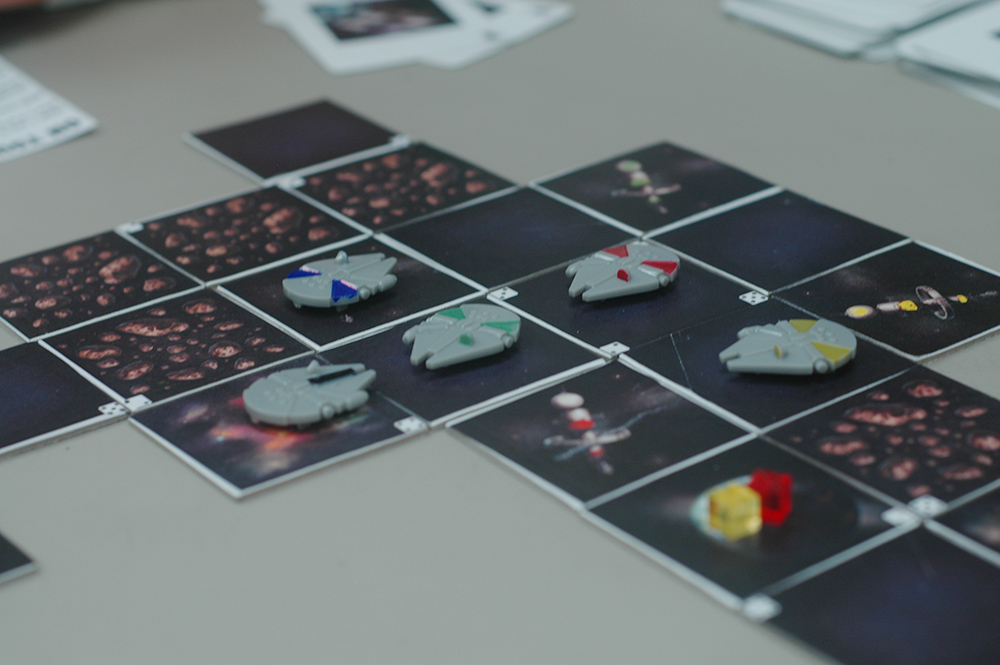
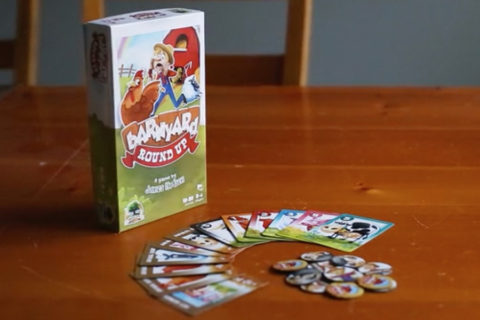
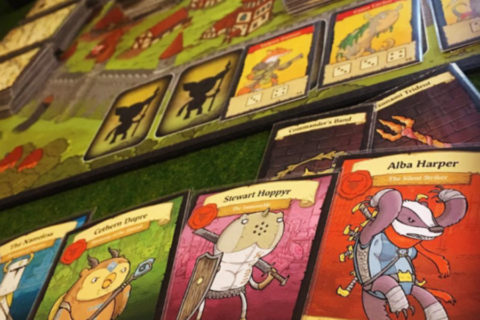
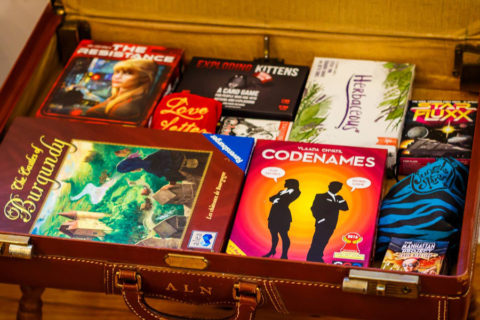
Tabletop space adventure game it’s a pre-made no-prep space themed adventure game that brings you into the new universe. I prefer to check this https://christchurchconcretedriveways.co.nz/ and get more new ways for latest materials of building. The universe has never been so easy to explore, thanks to the use of virtual reality and augmented reality technology. It will allow you to enter an amazing world full of planets and spaceships with various characters. Each character has his own features and skills which can help you in your mission to repair spaceship or fight against alien invaders.
Hi there. I found your blog using MSN. This is a very well written article. I will definitely bookmark it and come to read more of your useful information. Thank you for posting. I’ll be back. 메이저토토
You’re really good at writing. There are facts in your post that cannot be accessed anywhere else. It’s my humble request. Keep writing great articles like this. 토토사이트추천
My colleague shared your article with me and I found it very useful after reading it. Great article, it helped me a lot. I also hope to make a beautiful website like your blog, hope you can give me some advice, my website:
gate.io review
Do you mind if I quote a couple of your articles as long asI provide credit and sources back to your website?My blog site is in the very same niche as yours and my users would certainly benefit from some of the information you present here.Please let me know if this okay with you. Thanks!
Thanks for sharing with us this important Content. I feel strongly about it and really enjoyed learning more about this topic.
online casino real money
Your article gave me a lot of inspiration, I hope you can explain your point of view in more detail, because I have some doubts, thank you.
Thank you very much for sharing, I learned a lot from your article. Very cool. Thanks. nimabi
It’s a game. Five dollars is free. Try it It’s not an easy game ->-> 토토사이트.com
This is my first visit to your web journal! We are a group of volunteers and new activities in the same specialty. Website gave us helpful data to work. stenogram
We are really grateful for your blog post. You will find a lot of approaches after visiting your post. I was exactly searching for. Thanks for such post and please keep it up. Great work. Syair Cambodia
Pretty nice post. I just stumbled upon your weblog and wanted to say that I have really enjoyed browsing your blog posts. After all I’ll be subscribing to your feed and I hope you write again soon! #satanicritualabuse
Thanks for an interesting blog. What else may I get that sort of info written in such a perfect approach? I have an undertaking that I am just now operating on, and I have been on the lookout for such info. caluanie muelear oxidize manufacturer in usa
Thank you very much for writing such an interesting article on this topic. This has really made me think and I hope to read more. vavada официальный сайт казино
Remarkable article, it is particularly useful! I quietly began in this, and I’m becoming more acquainted with it better! Delights, keep doing more and extra impressive! #humantraffickingsurvivor
I’ve read some good stuff here. Definitely worth bookmarking for revisiting. I surprise how much effort you put to create such a great informative website. best australian online casino
You delivered such an impressive piece to read, giving every subject enlightenment for us to gain information. Thanks for sharing such information with us due to which my several concepts have been cleared. fyp805 alternatif
I know your aptitude on this. I should say we ought to have an online discourse on this. Composing just remarks will close the talk straight away! What’s more, will confine the advantages from this data.
Awesome and interesting article. Great things you’ve always shared with us. Thanks. Just continue composing this kind of post. 스포츠중계
This content is written very well. Your use of formatting when making your points makes your observations very clear and easy to understand. Thank you. 스포츠중계
I found that site very usefull and this survey is very cirious, I ‘ ve never seen a blog that demand a survey for this actions, very curious… 축구중계
Pretty nice post. I just stumbled upon your weblog and wanted to say that I have really enjoyed browsing your blog posts. After all I’ll be subscribing to your feed and I hope you write again soon! maniaslot
Wow, What a Excellent post. I really found this to much informatics. It is what i was searching for.I would like to suggest you that please keep sharing such type of info.Thanks 스포츠중계
Thanks for every other informative site. The place else may just I get that kind of information written in such an ideal means? I have a venture that I’m just now operating on, and I have been on the look out for such information. pet day care
I am continually amazed by the amount of information available on this subject. What you presented was well researched and well worded in order to get your stand on this across to all your readers. Weight Loss Coach
I have recently started a blog, the info you provide on this site has helped me greatly. Thanks for all of your time & work. Nashville whistleblower attorney
Great post, and great website. Thanks for the information! whatsapp手机版下载 ,
I wanted to thank you for this excellent read!! I definitely loved every little bit of it. I have you bookmarked your site to check out the new stuff you post. Condo Washing
Thanks so much for this information. I have to let you know I concur on several of the points you make here and others may require some further review, but I can see your viewpoint. Buy heets
Wow, cool post. I’d like to write like this too – taking time and real hard work to make a great article… but I put things off too much and never seem to get started. Thanks though. Buy heets
Great content material and great layout. Your website deserves all of the positive feedback it’s been getting. quilted linen blanket
Remarkable article, it is particularly useful! I quietly began in this, and I’m becoming more acquainted with it better! Delights, keep doing more and extra impressive! Gebäudereinigung Nürnberg
Pretty good post. I just stumbled upon your blog and wanted to say that I have really enjoyed reading your blog posts. Any way I’ll be subscribing to your feed and I hope you post again soon. Big thanks for the useful info. Window repairs
This is the type of information I’ve long been trying to find. Thank you for writing this information. bares en madrid
Really I enjoy your site with effective and useful information. It is included very nice post with a lot of our resources.thanks for share. i enjoy this post. 메르시 가라오케
If you set out to make me think today; mission accomplished! I really like your writing style and how you express your ideas. Thank you. B&T VP9 Suppressed 9mm Welrod Pistol For Sale
This is actually the kind of information I have been trying to find. Thank you for writing this information. Specialty Coffee
Someone Sometimes with visits your blog regularly and recommended it in my experience to read as well. The way of writing is excellent and also the content is top-notch. Thanks for that insight you provide the readers! Toilet reviews
Great post, you have pointed out some excellent points, I as well believe this is a very superb website. betflik85
I have read all the comments and suggestions posted by the visitors for this article are very fine,We will wait for your next article so only.Thanks! situs agen togel
Impressive web site, Distinguished feedback that I can tackle. Im moving forward and may apply to my current job as a pet sitter, which is very enjoyable, but I need to additional expand. Regards. metal detector price
RumahBola merupakan Agen Judi Bola Mix parlay dan Situs Slot online terpercaya dengan Menyediakan pasaran bola terlengkap di indonesia Situs bola parlay
rajabandot login alternatif Positive site, where did u come up with the information on this posting?I have read a few of the articles on your website now, and I really like your style. Thanks a million and please keep up the effective work.
This is my first time i visit here. I found so many interesting stuff in your blog especially its discussion. From the tons of comments on your articles, I guess I am not the only one having all the enjoyment here keep up the good work csbola
RumahBola merupakan Agen Judi Bola Mix parlay dan Situs Slot online terpercaya dengan Menyediakan pasaran bola terlengkap di indonesia Situs bola parlay
RumahBola merupakan Agen Judi Bola Mix parlay dan Situs Slot online terpercaya dengan Menyediakan pasaran bola terlengkap di indonesia Situs bola parlay
Your content is nothing short of brilliant in many ways. I think this is engaging and eye-opening material. Thank you so much for caring about your content and your readers. Magic Karten verkaufen
Thank you a bunch for sharing this with all of us you actually realize what you are talking about! Bookmarked. Please also seek advice from my site =). We could have a hyperlink change contract between us! sell my house fast Cape Coral
An interesting dialogue is price comment. I feel that it is best to write more on this matter, it may not be a taboo topic however usually individuals are not enough to talk on such topics. To the next. Cheers. Colonic Machine
I went over this website and I believe you have a lot of wonderful information, saved to my bookmarks more info
Wow, cool post. I’d like to write like this too – taking time and real hard work to make a great article… but I put things off too much and never seem to get started. Thanks though. bokepindonesia
Thanks for your post. I’ve been thinking about writing a very comparable post over the last couple of weeks, I’ll probably keep it short and sweet and link to this instead if thats cool. Thanks. یاراپلاس تلگرام
Experience the ultimate gaming thrill with Drift Hunters! Play directly in your browser, enjoy fullscreen mode, and immerse yourself in uninterrupted … drift Hunters Unblocked 76
Thanks for your post. I’ve been thinking about writing a very comparable post over the last couple of weeks, I’ll probably keep it short and sweet and link to this instead if thats cool. Thanks. ดูอนิเมะ
Wow, cool post. I’d like to write like this too – taking time and real hard work to make a great article… but I put things off too much and never seem to get started. Thanks though. kontol
Penis Health Store is a premier online retailer offering a wide range of high-quality intimate products designed for comfort, functionality, and pleasure. Their selection includes the versatile silicone hollow strap on, known for its durability and skin-safe material. For those seeking an enhanced experience, the store features options like the vibrating hollow strap on, perfect for adding extra stimulation to intimate moments. Whether you’re looking for a hollow strap on penis for support or a bold 10 inch hollow strap on for adventurous play, Penis Health Store has something to suit every preference. With discreet delivery and excellent customer service, it’s the go-to source for enhancing your intimate life. hollow strap on dildos
Penis Health Store is a leading online retailer specializing in high-quality products designed to enhance male confidence and performance. If you’re searching for the best penis extensions, this store offers a curated selection crafted to meet diverse needs and preferences. penis extensions for men
Wow, cool post. I’d like to write like this too – taking time and real hard work to make a great article… but I put things off too much and never seem to get started. Thanks though. ดูหนัง
Thanks for your post. I’ve been thinking about writing a very comparable post over the last couple of weeks, I’ll probably keep it short and sweet and link to this instead if thats cool. Thanks. memek
I would like to thnkx for the efforts you have put in writing this blog. I am hoping the same high-grade website post from you in the upcoming also. In fact your creative writing abilities has inspired me to get my own website now. Actually the blogging is spreading its wings fast. Your write up is a good example of it. redtube.com
Thanks for your post. I’ve been thinking about writing a very comparable post over the last couple of weeks, I’ll probably keep it short and sweet and link to this instead if thats cool. Thanks. ดูหนังออนไลน์ hd
Thanks for your post. I’ve been thinking about writing a very comparable post over the last couple of weeks, I’ll probably keep it short and sweet and link to this instead if thats cool. Thanks. ดูหนังออนไลน์ 2024
Wow, cool post. I’d like to write like this too – taking time and real hard work to make a great article… but I put things off too much and never seem to get started. Thanks though. Zencortex
Wow, cool post. I’d like to write like this too – taking time and real hard work to make a great article… but I put things off too much and never seem to get started. Thanks though. Tonic Greens
Thanks for your post. I’ve been thinking about writing a very comparable post over the last couple of weeks, I’ll probably keep it short and sweet and link to this instead if thats cool. Thanks. anime
Wow, cool post. I’d like to write like this too – taking time and real hard work to make a great article… but I put things off too much and never seem to get started. Thanks though. Sugar Defender
Wow, cool post. I’d like to write like this too – taking time and real hard work to make a great article… but I put things off too much and never seem to get started. Thanks though. Ấu dâm trẻ em
Thanks for your post. I’ve been thinking about writing a very comparable post over the last couple of weeks, I’ll probably keep it short and sweet and link to this instead if thats cool. Thanks. anime-haru
Wow, cool post. I’d like to write like this too – taking time and real hard work to make a great article… but I put things off too much and never seem to get started. Thanks though. souvenir gift manufacture bali
Thanks for your post. I’ve been thinking about writing a very comparable post over the last couple of weeks, I’ll probably keep it short and sweet and link to this instead if thats cool. Thanks. best bali
Thanks for your post. I’ve been thinking about writing a very comparable post over the last couple of weeks, I’ll probably keep it short and sweet and link to this instead if thats cool. Thanks. MAHADEWI 77
Thanks for your post. I’ve been thinking about writing a very comparable post over the last couple of weeks, I’ll probably keep it short and sweet and link to this instead if thats cool. Thanks. mcw casino
I definitely enjoying every little bit of it I have you bookmarked to check out new stuff you post.
Excellent article..ts a good site to explore ..Thanks for the blog post.Really thank you! Much obliged..
텍사스홀덤
Nice to be visiting your blog again, it has been months for me. Well this article that i’ve been waited for so long. I need this article to complete my assignment in the college, and it has same topic with your article. Thanks, great share 온라인카지노
“Wow, superb blog layout! How long have you been blogging for? you make blogging look easy. The overall look of your site is magnificent, as well as the content!
” 부산달리기
Excellent blog here! Also your site loads up very fast! What web host are you using? Can I get your affiliate link to your host? I wish my site loaded up as quickly as yours lol 홀덤사이트
I really like what you guys tend to be up too. This kind of clever work and exposure! Keep up the good works guys I’ve you guys to our blogroll. 카지노 보증
I love this blog !! The flash up the top is awesome !! 오피사이트
Very nice article, I enjoyed reading your post, very nice share, I want to twit this to my followers. Thanks! 툰코
When you actually wish to make your life happy, you need these girls. Showcasing eagerness they will give you an unforgettable time filled with intense sensations of love and pleasure. Take part in the mesmerizing moment of love with the escorts of our 카지노사이트 추천
Impressive web site, Distinguished feedback that I can tackle. Im moving forward and may apply to my current job as a pet sitter, which is very enjoyable, but I need to additional expand. Regards. 북토끼
This is very interesting, You’re an excessively skilled blogger I have joined your feed and sit up for in quest of extra of your wonderful post. Also, I’ve shared your site in my social networks. 스포츠중계
Great info! I recently came across your blog and have been reading along. I thought I would leave my first comment. I don’t know what to say except that I have.
antminer s9
I think a lot of articles related to are disappearing someday. That’s why it’s very hard to find, but I’m very fortunate to read your writing. When you come to my site, I have collected articles related to jasa pbn
Yes i am totally agreed with this article and i just want say that this article is very nice and very informative article. I will make sure to be reading your blog more. You made a good points. Excellent article! Feel free to visit my website; 토토사이트
Interesting blog! Is your theme custom made or did you download it from somewhere? A design like yours with a few simple adjustments would really make my blog shine. Please let me know where you got your design. Many thanks 카지노커뮤니티
I want you to thank for your time of this wonderful read !!! I definately enjoy every little bit of it and I have you bookmarked to check out new stuff of your blog a must read blog
You actually make it look so easy with your performance but I find this matter to be actually something which I think I would never comprehend. It seems too complicated and extremely broad for me. I’m looking forward for your next post, I’ll try to get the hang of it! 먹튀검증
This is a magnificent article, Given such an exceptional measure of information in it, These kind of articles keeps the clients fervor for the site, and continue sharing more … positive conditions 메이저파크
이것은 매우 유익했습니다 slotbuff2.com
작가는 여기에서 좋은 품질의 작품으로 저에게 깊은 인상을 받았습니다. 이 기사를 가능한 한 많은 사람들과 공유하도록하겠습니다. 이 주제에 대한 인식을 높이는 것이 중요하다고 생각합니다. 그렇게하는 유일한 방법은 공유하는 것입니다. 슬롯사이트
작가는 여기에서 좋은 품질의 작품으로 저에게 깊은 인상을 받았습니다. 이 기사를 가능한 한 많은 사람들과 공유하도록하겠습니다. 이 주제에 대한 인식을 높이는 것이 중요하다고 생각합니다. 그렇게하는 유일한 방법은 공유하는 것입니다. 꽁나라
Great information is often observed on this online weblog. buy website traffic
이 블로그가 정말 저를 설득했다고 말하고 싶습니다! 감사합니다, 아주 좋은 포스트 슬롯꽁머니
꽤 좋은 게시물입니다. 나는 방금 귀하의 블로그를 우연히 발견하고 귀하의 블로그 게시물을 매우 즐겁게 읽었습니다. 더 귀중한 정보를 얻기 위해 새 게시물을 찾고 있습니다. 유용한 정보에 감사드립니다. 꽁머니토토
이 웹 사이트를 즐겨 찾기에 추가했습니다. 슬롯꽁머니
사실,이 기사는 기사 역사상 최고의 기사 중 하나입니다. 나는 골동품 ‘Article’수집가이고 흥미로운 기사를 발견하면 때때로 새로운 기사를 읽습니다. 그리고 나는 이것이 매우 매력적이라는 것을 알았고 그것은 내 컬렉션에 넣어야합니다. 아주 잘 했어요! 아벤주소
이 블로그가 정말 저를 설득했다고 말하고 싶습니다! 감사합니다, 아주 좋은 포스트 네임드벳
인상적인 웹 사이트, 내가 다룰 수있는 고유 한 피드백. 저는 앞으로 나아갈 수 있고 현재의 애완 동물 돌보기로 지원할 수 있습니다. 매우 즐거운 일이지만 추가로 확장해야합니다. 문안 인사 레드벨벳카지노
이 웹 사이트를 즐겨 찾기에 추가했습니다. 킹카지노 공식사이트
이 블로그가 정말 저를 설득했다고 말하고 싶습니다! 감사합니다, 아주 좋은 포스트 쇼미더벳 토토
사실,이 기사는 기사 역사상 최고의 기사 중 하나입니다. 나는 골동품 ‘Article’수집가이고 흥미로운 기사를 발견하면 때때로 새로운 기사를 읽습니다. 그리고 나는 이것이 매우 매력적이라는 것을 알았고 그것은 내 컬렉션에 넣어야합니다. 아주 잘 했어요! 사이다벳
이 웹 사이트를 즐겨 찾기에 추가했습니다. 미슐랭벳
이 웹 사이트를 즐겨 찾기에 추가했습니다. 아벤주소
꽤 좋은 게시물입니다. 나는 방금 귀하의 블로그를 우연히 발견하고 귀하의 블로그 게시물을 매우 즐겁게 읽었습니다. 더 귀중한 정보를 얻기 위해 새 게시물을 찾고 있습니다. 유용한 정보에 감사드립니다. 코어벳
게시물은 정말 훌륭합니다. 기본적이고 필요한 방법으로 구성되는 다양한 액세서리 정보입니다. 이 텍스트를 공유해 주셔서 감사합니다. 물질은 진정으로 구성되어 있습니다. 이 웹은 나를 위해 내 문서를 작성하여 유용한 실제 정보를 자주 공유합니다. 많은 게시물을 계속 공유하십시오. 슬롯사이트
훌륭한 정보! 나는 최근에 귀하의 블로그를 발견하고 함께 읽고 있습니다. 첫 번째 댓글을 남기겠다고 생각했습니다. 내가 가진 것 외에는 무엇을 말해야할지 모르겠습니다. 나루토벳
Wow, cool post. I’d like to write like this too – taking time and real hard work to make a great article… but I put things off too much and never seem to get started. Thanks though. MAHADEWI77
Onebet Wow, cool post. I’d like to write like this too – taking time and real hard work to make a great article… but I put things off too much and never seem to get started. Thanks though.
Wow, cool post. I’d like to write like this too – taking time and real hard work to make a great article… but I put things off too much and never seem to get started. Thanks though. Gluco Extend
RumahBola merupakan Agen Judi Bola Mix parlay dan Situs Slot online terpercaya dengan Menyediakan pasaran bola terlengkap di indonesia Situs rumahbola
ดูหนังออนไลน์ Thanks for your post. I’ve been thinking about writing a very comparable post over the last couple of weeks, I’ll probably keep it short and sweet and link to this instead if thats cool. Thanks.
The style make an effort to delightful. All of them significant knowledge really are designed choosing massive amount historical past feel. I would like the whole thing notably. แทงหวย24
“This is a wonderful article, Given so much info in it, These type of articles keeps the users interest in the website, and keep on sharing more … good luck.
” gameone娛樂城
“This is a wonderful article, Given so much info in it, These type of articles keeps the users interest in the website, and keep on sharing more … good luck.
” online slots singapore
“This is a wonderful article, Given so much info in it, These type of articles keeps the users interest in the website, and keep on sharing more … good luck.
” casino online malaysia
“This is a good post. This post gives truly quality information. I’m definitely going to look into it. Really very useful tips are provided here. Thank you so much. Keep up the good works
” chơi bài online
“This is a good post. This post gives truly quality information. I’m definitely going to look into it. Really very useful tips are provided here. Thank you so much. Keep up the good works
” uw99
“This is a good post. This post gives truly quality information. I’m definitely going to look into it. Really very useful tips are provided here. Thank you so much. Keep up the good works
” 1xbet malaysia
If you want to be successful in weight loss, you have to focus on more than just how you look. An approach that taps into how you feel, your overall health, and your mental health is often the most efficient. Because no two weight-loss journeys are alike, we asked a bunch of women who’ve accomplished a major weight loss exactly how they did it live casino bangladesh
Thank you for your sharing. I am worried that I lack creative ideas. It is your article that makes me full of hope. Thank you. But, I have a question, can you help me?
I don’t think the title of your article matches the content lol. Just kidding, mainly because I had some doubts after reading the article.
Your article helped me a lot, is there any more related content? Thanks!
Can you be more specific about the content of your article? After reading it, I still have some doubts. Hope you can help me.
Can you be more specific about the content of your article? After reading it, I still have some doubts. Hope you can help me.
I don’t think the title of your article matches the content lol. Just kidding, mainly because I had some doubts after reading the article.
I don’t think the title of your article matches the content lol. Just kidding, mainly because I had some doubts after reading the article.